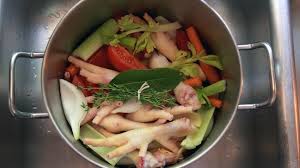
Blanched Carrot & Kale Salad in Orange Ginger Vinaigrette.
These last few weeks I’ve been featuring a lovely seasonal dish, Carrot Kale Salad in Orange Ginger Vinaigrette, which I first made with cooking camp students (see late Aug posts). I handed it out at the Farm 2 School Community BBQ last week, at the little Farmers’ Market which pops up in the parking lot of the Inver Grove Hts Community Center, and at a Health & Wellness fair.
I will also be teaching this and 3 other kale dishes in Super Food classes @ Robbinsdale and Inver Grove Hts community education next week. More on that in next post.
This salad rocks! Everybody loves it. The full recipe for salad and the vinaigrette is now on the Recipe page. It’s all about Complementarity. As any art students will tell you, the color orange’s opposite is the color green. Similarly, the natural sweetness of carrots balances the earthy ‘green’ taste of kale, and, orange juice enlivens them both. And you know that brightly colored food are the most healthful; antioxidants are what make them colorful in the first place.
This vinaigrette is fairly tangy at first, perhaps a bit sour for some kids unused to vinegar — but it mellows after a day. It also depends on the sweetness of orange juice concentrate you use and whether you use white wine vinegar or cider vinegar. It’s excellent on mixed green salads and grain salads. Combine this carrot kale salad with Quinoa, for instance.

“Dinosaur” lacinato kale (back) and regular curly kale (front).
Quite a few people told me they liked kale in this salad more than they expected. Perhaps because blanching fresh kale takes off the bitter edge while producing a chewy texture. Blanching leafy greens like kale or collards is a great way to keep their deep green color & nutrients. It’s also really fast. As you & yours come to like blanched kale, use more kale and fewer carrots in this salad.
Blanching is also the first step in freezing these hardy leafy greens. Anytime you plan a dish with kale/collards, blanch 2 batches and freeze one in a ziploc for later. Right now, they’re a dollar/bunch at the farmers’ market, where they’ll be available thru Dec.
About stalks: you can chop up the upper stalks with the leaves or strip them off, depending on the dish. For a stew or soup, leave them on, since they’ll get soft during simmering. For a salad, a saute or a quick braised dish, strip them off. (If you wish, chop stalks finely and save for that stew/soup.)

Chopped kale ready to be blanched.
TECHNIQUE TIP: Strip leaves off kale or collards easily with a ‘corn-shucking’ motion. Grab a stalk in one hand, leaves pointing down. Fold the 2 sides of leaves together with your other hand, with rib facing the opposite way. Pull down sharply like you are shucking corn, and then only the rib remains. Roll 4-5 of the rib-less leaves together like a cigar, then chop into shreds.
Now what?
1. Add raw shreds to cabbage or mixed green salad.
2. Add raw shreds to ramen noodle or Posole soup.
3. Blanch, drain, squeeze out water & freeze.
4. Blanch for salads. Drizzle w/ sesame dressing (ala co-op deli) or peanut dressing.
6. Saute w/ garlic, olive oil, lemon juice; or, add sesame oil, soy sauce & chilli pepper flakes.
7. Add to quiche, casseroles, ratatouille. Throw into pasta sauce, cassoulets, curry, soup. Nice in chili & any bean dish. (Use ‘search” to find past posts on Beans & Greens.)

Kale shreds, blanched. My favorite long-handled sieve.
Back to the Carrots & Kale salad. Like 90% of my salads, it keeps for a week+. When you’re tired of it as a salad, simmer with a little water or broth — or coconut milk — 6-8 min til tender and serve hot.
UTENSIL TIP: go to Asian grocery and buy a sieve with long handle for scooping out blanched or boiled veggies, noodles, potatoes, etc. This handy utensil saves time, since it’s bigger than a slotted spoon. Not pouring out the hot water means you can re-use it for multiple veggie-blanching batches and soup, too.
The sieve comes in different bowl sizes and handle lengths and range from $3 – 7. Don’t bother getting a small one.























